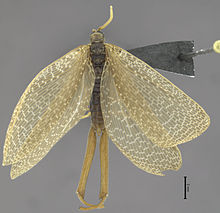
Flea, the common name for the order Siphonaptera, includes 2,500 species of small flightless insects that survive as external parasites of mammals and birds. Fleas live by consuming blood, or hematophagy, from their hosts. Adult fleas grow to about 3 millimetres long, are usually brown, and have bodies that are "flattened" sideways or narrow, enabling them to move through their host's fur or feathers. They lack wings, but have strong claws preventing them from being dislodged, mouthparts adapted for piercing skin and sucking blood, and hind legs extremely well adapted for jumping. They are able to leap a distance of some 50 times their body length, a feat second only to jumps made by another group of insects, the superfamily of froghoppers. Flea larvae are worm-like with no limbs; they have chewing mouthparts and feed on organic debris left on their host's skin.

The freckled duck is a waterfowl species endemic to Australia. The freckled duck has also been referred to as the monkey duck or oatmeal duck. These birds are usually present in mainland Australia, but disperse to coastal and subcostal wetlands in the dry period. During such times it is common for the freckled duck population to congregate in flocks in the same area, giving the impression that they are more common than they really are.

The numbat also known as the noombat or walpurti, is an insectivorous marsupial. It is diurnal and its diet consists almost exclusively of termites.

Uvarovite is a chromium-bearing garnet group species with the formula: Ca3Cr2(SiO4)3. It was discovered in 1832 by Germain Henri Hess who named it after Count Sergei Semenovitch Uvarov (1765–1855), a Russian statesman and amateur mineral collector. It is classified in the ugrandite group alongside the other calcium-bearing garnets andradite and grossular.

Mecoptera are an order of insects in the superorder Endopterygota with about six hundred species in nine families worldwide. Mecopterans are sometimes called scorpionflies after their largest family, Panorpidae, in which the males have enlarged genitals that look similar to the stingers of scorpions, and long beaklike rostra. The Bittacidae, or hangingflies, are another prominent family and are known for their elaborate mating rituals, in which females choose mates based on the quality of gift prey offered to them by the males. A smaller group is the snow scorpionflies, family Boreidae, adults of which are sometimes seen walking on snowfields. In contrast, the majority of species in the order inhabit moist environments in tropical locations.
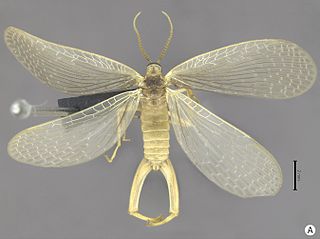
Meropeidae is a family of tiny scorpionflies within the order Mecoptera with only three living species, commonly referred to as "earwigflies". These include the North American Merope tuber, the Western Australian Austromerope poultoni, and the recently discovered South American A. brasiliensis. The biology of these species is essentially unknown, and their larvae have never been seen. The disjunct distribution suggests a common origin before the breakup of the ancient supercontinent of Pangaea. There are two undisputed extinct genera, Boreomerope antiqua known from an isolated wing found in the Middle Jurassic Itat Formation of Siberia and Burmomerope with three species from the Cenomanian aged Burmese amber. As such, the extant members of this family can be considered living fossils. These insects are also of interest due to their presumed basal position in the order Mecoptera. Thaumatomerope with four described species all from the Madygen Formation in Kyrgyzstan has historically sometimes been included within the family, it was placed into its own monotypic family, "Thaumatomeropidae." in 2002.

The dusky shark is a species of requiem shark, in the family Carcharhinidae, occurring in tropical and warm-temperate continental seas worldwide. A generalist apex predator, the dusky shark can be found from the coast to the outer continental shelf and adjacent pelagic waters, and has been recorded from a depth of 400 m (1,300 ft). Populations migrate seasonally towards the poles in the summer and towards the equator in the winter, traveling hundreds to thousands of kilometers. One of the largest members of its genus, the dusky shark reaches 4.2 m (14 ft) in length and 347 kg (765 lb) in weight. It has a slender, streamlined body and can be identified by its short round snout, long sickle-shaped pectoral fins, ridge between the first and second dorsal fins, and faintly marked fins.
Nannochoristidae is a family of scorpionflies with many unusual traits. It is a tiny, relict family of about eight species, with members of the genus Nannochorista occurring in New Zealand, southeastern Australia, Tasmania, and Chile, so is probably of Gondwanan origin. The adults look like scorpionflies with more pointed, elongated wings. Most mecopteran larvae are eruciform, or shaped like caterpillars. Nannochoristid larvae, however, are elateriform, or shaped like wireworm or click beetle larvae. They are also the only entirely aquatic Mecoptera. Wing venation suggests a close relationship to dipterans. They are predatory, primarily on the larvae of aquatic Diptera.

Bittacidae is a family of scorpionflies commonly called hangingflies or hanging scorpionflies.

Boreidae, commonly called snow scorpionflies, or in the British Isles, snow fleas are a very small family of scorpionflies, containing only around 30 species, all of which are boreal or high-altitude species in the Northern Hemisphere. Recent research indicates the boreids might be more closely related to fleas than to other scorpionflies, which would render the order Mecoptera paraphyletic if the order Siphonaptera is excluded from it.

Eomeropidae is a family of aberrant, flattened scorpionflies represented today by only a single living species, Notiothauma reedi, known from the Nothofagus forests in southern Chile, while all other recognized genera in the family are known only as fossils, with the earliest definitive fossil known from Liassic-aged strata, and the youngest from Paleogene-aged strata.

The western rosella, or moyadong, is a species of parrot endemic to southern Western Australia. The head and underparts are bright red, and the back is mottled black; a yellow patch at the cheek distinguishes it from others of the genus Platycercus. Adults of the species exhibit sexual dimorphism with the females duller overall; juveniles lack the striking colours of mature birds and the characteristic patterning is not as easily distinguished. Their communication call is a softly delivered pink-pink sound, and much of their behaviour is comparatively unobtrusive. Their habitat is in eucalypt forests and woodlands, where they often remain unobserved until they appear to feed on seeds at nearby cleared areas.

The Western barred bandicoot, also known as the Marl, is a small species of bandicoot; now extinct across most of it’s former range, the western barred bandicoot only survives on offshore islands and in fenced sanctuaries on the mainland.

The western pygmy possum, also known as the southwestern pygmy possum or the mundarda, is a small marsupial found in Australia. Genetic studies indicate its closest relative is probably the eastern pygmy possum, from which its ancestors diverged around eight million years ago.

The blue-breasted fairywren, or blue-breasted wren, is a species of passerine bird in the Australasian wren family, Maluridae. It is non-migratory and endemic to southern Western Australia and the Eyre Peninsula in South Australia. Exhibiting a high degree of sexual dimorphism, the male adopts a brilliantly coloured breeding plumage, with a bright blue crown, ear coverts and upper back, red shoulders, contrasting with a dark blue throat, grey-brown tail and wings and pale underparts. Non-breeding males, females and juveniles have predominantly grey-brown plumage. No separate subspecies are recognised.

The Rosenberg's monitor is an Australian species of varanid reptile found in southern regions of the continent. They are large and fast predators with rugged bodies and long tails, having a combined length up to 1.5 metres, that will consume any smaller animal that is pursued and captured or found while foraging. They occur in the Australian Capital Territory, New South Wales, South Australia, Victoria, where it may be rare or locally common, and more frequently observed in Western Australia, where it is sometimes abundant.
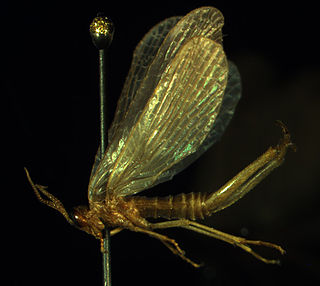
Merope tuber, the earwigfly or forcepfly, is the only species in the genus Merope, and the only living member of the family Meropeidae in North America. It occurs throughout the east from Ontario to Georgia, and west to Kansas. Recently the insect has also been found in Florida. This insect's most distinguishing feature is the segmented cerci on the male abdomen. The function of these is not known, but they may be used during courtship. Much is unknown about the adults, which are nocturnal and secretive, sometimes found under logs or in malaise traps near streams, or attracted to lights at nighttime. No M. tuber or Meropeid larvae have been identified. The insect is characterized by long wings with many veins and no ocelli. There is a region of interlocking sclerites that holds the jugum and scutellum on the middle thoracic segment together. This may be used to keep the wings together when pushing up through dirt. A similar apparatus is found in cicadas and ground-dwelling beetles, so it may be that the winged adults dig in soil. The flat appearance of the insect suggests that the insect dwells close to the ground in fissures and other small ground openings, as does the lack of ocelli.
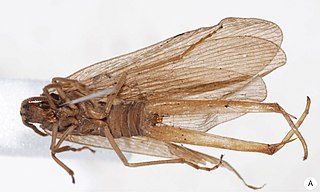
The forcepfly Austromerope poultoni is one of only two representatives of the genus Austromerope, and the only member of the family Meropeidae in the Eastern Hemisphere. It is endemic to Western Australia, typically around 20mm long, with large forceps-like structures at the tail and two pairs of wings. Only adults and eggs from captured adults are known - no larval stage has been seen. It is found in a variety of habitats, including woodland, Jarrah forest, and sand plain vegetation.
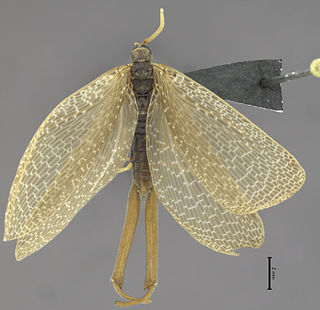
The forcepfly Austromerope brasiliensis is one of only two living representatives of the genus Austromerope. It is apparently endemic to Brazil, with large forceps-like structures at the tail and two pairs of wings. Only adults are known - no larval stage has been seen.
Hakea oligoneura is a small rare shrub known from only a few populations south of Perth, Western Australia growing exclusively on coastal limestone ridges. It has cream-white flowers and stiff, thick yellow-greenish leaves.
